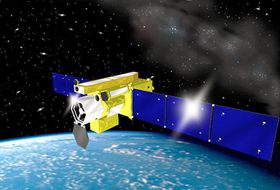
 |
 |
|
The Extreme Ultraviolet Imaging Spectrometer (EIS) is being built by a consortium led by MSSL and will fly on the Japanese Solar-B mission, due for launch in August 2005.
Solar-B will study the magnetic fields in the photosphere and related these to the highly dynamical behaviour of the transition region and corona. There are three instruments aboard Solar-B; the Solar Optical Telescope (SOT) which will observe the photosphere and the corona in optical light and will also measure solar magnetic fields using a vector magnetogram, the X-ray telescope (XRT) which will observe the corona, and EIS. EIS will obtain EUV spectra and images of plasma from the transition region through to the corona and solar flares. High spectral and spatial resolution is required to enable accurate determination of plasma characteristics such as temperatures, densities and velocity flows.
The CCD camera for EIS is being developed here at MSSL. (The CCDs for SOT are being procured on behalf of Lockheed Martin from Marconi and will be characterised here at MSSL before delivery).
The camera will consist of two CCDs at the focal plane, to cover two
separate wavelength ranges. The CCDs selected are Marconi (formerly EEV)
42-20s. Brief details of the CCDs and the camera are given below, to find
more about the camera design, follow the links below this table.
| CCD size | 2048 pixels long (spectral direction) by 1024 pixels high (spatial direction) |
| Pixel size | 13.5µm square |
| Device type | Backilluminated CCD with a Quantum Efficiency of ~ 80%. The device is a Multi pinned phase device to ensure low thermal noise |
| Camera read out rate | 500,000 pixels per second. It will take about a second to download a complete CCD image |
| Camera digitisation | 14 bits |
Click on the following links for more information about the SOLAR-B EIS CCD camera development programme
| CCD camera requirements | EIS Camera Design | Details of EIS CCDs | Solar-B Homepage | Presentations on EIS |
 |
 |
 |
|
| CCD
Group |
Detector Physics | MSSL Homepage | UCL Homepage |
This page was prepared by Chris McFee